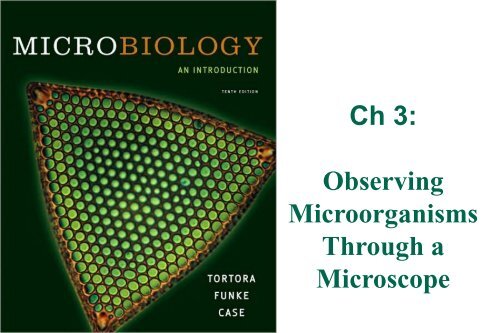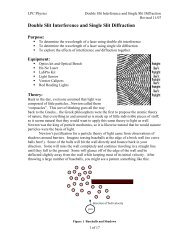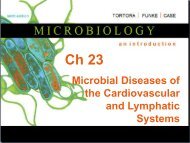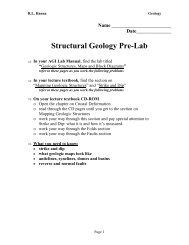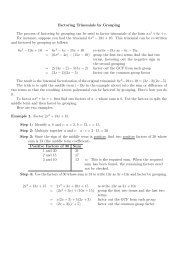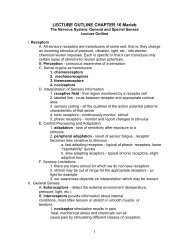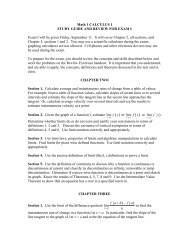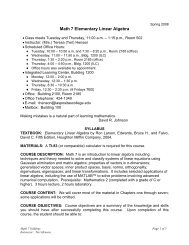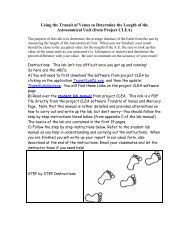Ch 3: Observing Microorganisms Through a Microscope
Ch 3: Observing Microorganisms Through a Microscope
Ch 3: Observing Microorganisms Through a Microscope
Create successful ePaper yourself
Turn your PDF publications into a flip-book with our unique Google optimized e-Paper software.
<strong>Ch</strong> 3:<br />
<strong>Observing</strong><br />
<strong>Microorganisms</strong><br />
<strong>Through</strong> a<br />
<strong>Microscope</strong>
Q&A<br />
Acid-fast staining of a<br />
patient’s sputum is a<br />
rapid, reliable, and<br />
inexpensive method to<br />
diagnose tuberculosis.<br />
What color would<br />
bacterial cells appear if<br />
the patient has<br />
tuberculosis?
Objectives<br />
Review the metric units of measurement<br />
Define total magnification and resolution<br />
Explain how electron and light microscopy differ<br />
Differentiate between acidic and basic dyes<br />
Compare simple, differential, and special stains<br />
List the steps in preparing a Gram stain. Describe the<br />
appearance of Gram-positive and Gram-negative<br />
cells after each step<br />
Compare and contrast Gram stain and acid-fast stain<br />
Explain why endospore and capsule stains are used
Units of Measurement<br />
Review Table 3.1<br />
• 1 µm = ______ m = ______ mm<br />
• 1 nm = ______ m = ______ mm<br />
• 1000 nm = ______ µm<br />
• 0.001 µm = ______ nm
Sizes Among <strong>Microorganisms</strong><br />
• Protozoa: 100 µm<br />
• Yeasts: 8 µm<br />
Cells Alive –<br />
How big is a . . .?<br />
• Bacteria: 1 - 5 µm (some much longer than<br />
wide)<br />
• Rickettsia: 0.4 µm = _________ nm<br />
• <strong>Ch</strong>lamydia and Mycoplasma: 0.25 µm<br />
• Viruses: 20 – 250 nm
Principles of the Compound Light<br />
<strong>Microscope</strong><br />
Magnification: Ocular and<br />
objective lenses of<br />
compound microscope (total<br />
mag.?)<br />
Resolution: Ability of lens to . . .<br />
Maximum resolving power ___ m<br />
Contrast: Stains change refractive<br />
index contrast between<br />
bacteria and surrounding medium<br />
Fig 3.1
Refractive Index<br />
Fig 3.3<br />
• Measures light-bending<br />
ability of a medium<br />
• Light may bend in air so<br />
much that it misses the<br />
small high-magnification<br />
lens.<br />
• Immersion oil is used to<br />
keep light from bending.
Microscopy: The Instruments<br />
Brightfield Microscopy<br />
• Simplest of all the<br />
optical microscopy<br />
illumination. techniques<br />
• Dark objects are visible<br />
against a bright<br />
background.<br />
Darkfield Microscopy<br />
• Light objects visible<br />
against dark background.<br />
• used to enhance the<br />
contrast in unstained<br />
samples.<br />
• Instrument of choice for<br />
spirochetes
Spirochetes (Treponema pallidum) viewed with darkfield microscope
Fluorescence Microscopy<br />
• Uses UV light.<br />
• Fluorescent substances<br />
absorb UV light and emit<br />
visible light.<br />
• Cells may be stained with<br />
fluorescent chemicals<br />
(fluorochromes).<br />
• Immunofluorescence<br />
Fig 3.6; T. pallidum
Figure 3.6a<br />
Fig 3.6b<br />
Principle of<br />
Immunofluorescence
Electron Microscopy: Detailed Images of<br />
Cell Parts<br />
Uses electrons, electromagnetic lenses, and<br />
fluorescent screens<br />
Electron wavelength ~ 100,000 x smaller than<br />
visible light wavelength<br />
Specimens may be stained with heavy metal<br />
salts<br />
Two types of EMs:?
SEM or TEM?<br />
Bacterial division<br />
Leaf surface
?<br />
10,000-100,000; resolution 2.5 nm.
Rod-shaped Mycobacterium avium
Preparation of Specimens for Light<br />
Microscopy<br />
• Staining Techniques Provide Contrast<br />
• Smear air-dry heat-fix<br />
• Basic dyes: cationic chromophore<br />
• Acidic dyes: anionic chromophore <br />
negative staining (good for capsules)<br />
• Three types of staining techniques:<br />
Simple, differential, and special
Simple Stains<br />
• Use a single basic<br />
dye.<br />
• A mordant may be<br />
used to hold the<br />
stain or coat the<br />
specimen to<br />
enlarge it.<br />
Differential Stains<br />
React differently with<br />
different bacteria<br />
• Gram stain<br />
• Acid fast stain
Review of different staining techniques<br />
Important Staining Reactions in Microbiology<br />
For Gram stain<br />
technique compare<br />
to Fig 3-12
Gram Stain<br />
crystal violet<br />
safranin
Acid Fast Stain<br />
• Cells that retain a basic stain in the presence of<br />
acid-alcohol are called acid-fast.<br />
• Non–acid-fast cells lose the primary stain when<br />
rinsed with acid-alcohol, and are counterstained<br />
with a different color basic stain
Special Stains<br />
See Fig 3.14<br />
• Endospore stain: Heat is<br />
required to drive a stain into the<br />
endospore.<br />
• Flagella staining: requires a<br />
mordant to make the flagella wide<br />
enough to see.<br />
• Capsule stain uses basic stain<br />
and negative stain


